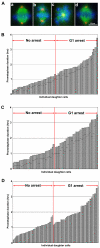Prolonged prometaphase blocks daughter cell proliferation despite normal completion of mitosis
- PMID: 20832310
- PMCID: PMC2946429
- DOI: 10.1016/j.cub.2010.08.018
Prolonged prometaphase blocks daughter cell proliferation despite normal completion of mitosis
Abstract
The mitotic checkpoint maintains genomic stability by blocking the metaphase-anaphase transition until all kinetochores attach to spindle microtubules [1, 2]. However, some defects are not detected by this checkpoint. With low concentrations of microtubule-targeting agents, the checkpoint eventually becomes satisfied, though the spindles may be short and/or multipolar [3, 4] and the fidelity of chromosome distribution and cleavage completion are compromised. In real life, environmental toxins, radiation, or chemotherapeutic agents may lead to completed but inaccurate mitoses. It has been assumed that once the checkpoint is satisfied and cells divide, the daughter cells would proliferate regardless of prometaphase duration. However, when continuously exposed to microtubule inhibitors, untransformed cells eventually slip out of mitosis after 12-48 hr and arrest in G1 [5-8] (see also [9]). Interestingly, transient but prolonged treatments with nocodazole allow completion of mitosis, but the daughter cells arrest in interphase [10, 11] (see also [9, 12]). Here we characterize the relationship between prometaphase duration and the proliferative capacity of daughter cells. Our results reveal the existence of a mechanism that senses prometaphase duration; if prometaphase lasts >1.5 hr, this mechanism triggers a durable p38- and p53-dependent G1 arrest of the daughter cells despite normal division of their mothers.
Copyright © 2010 Elsevier Ltd. All rights reserved.
Figures




References
-
- Musacchio A, Salmon ED. The spindle-assembly checkpoint in space and time. Nat Rev Mol Cell Biol. 2007;8:379–393. - PubMed
Publication types
MeSH terms
Substances
Grants and funding
LinkOut - more resources
Full Text Sources
Other Literature Sources
Research Materials
Miscellaneous

